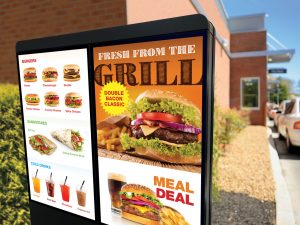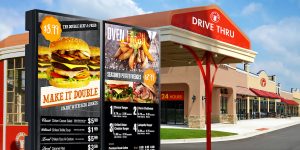
Outdoor displays reflect years of engineering designed to make running an LCD in harsh environments as crisp as running an LCD on the reception wall of an office.
Self-service solutions for everyone
As customers’ behaviours changed in reaction to health and safety protocols, businesses were forced to quickly adapt to provide them with a safer experience. One of the most popular methods of doing this was to introduce contactless or self-service solutions. Whether it was during the ordering process or at checkout, businesses that offered flexible display technology, such as self-guided kiosks, earned high praise from their customers.
These self-guided kiosks present many advantages, especially when consumers are extra cautious about their proximity to others and the surfaces they touch.
For example, with the right technology, these kiosks can provide fast shopping transactions, which allows operators to speed up their services, improve their order accuracy, and improve the overall experience to secure customer loyalty.

The need for reliable outdoor digital signage is almost non-negotiable. Restaurants have come to rely on it to communicate menu items, new products, promotions, nutritional information, rewards programs, and prices.
Kiosks can also be informative to consumers by delivering on-demand answers about products, pricing, and availability. Finally, and most relevant to these current times, kiosks give customers and staff peace of mind when they are trying to abide by physical distancing and hygiene guidelines.
By speeding up transactions, more consumers can be served, which requires businesses to hire more staff to cook food or manage inventory or stock shelves. The technology also allows managers to reallocate staff to other duties so the business’ overall efficiency and experience for customers is improved. The rise in popularity of self-guided kiosks has been particularly apparent in the QSR industry, where consumers have quickly adapted to reviewing the menu and promotions and selecting their orders using this technology. Top-of-the-line kiosks even boast payment pads, card readers, receipt printers, QR/barcode scanners, optional near-field communication (NFC), and Wi-Fi.
Recently, St-Hubert restaurants in Quebec installed touchless interactive kiosks that allowed customers to order their meals without having to physically touch the surface of the screen. Instead, the kiosks’ cutting-edge AIR TOUCH technology can read their gestures mid-air from 50 mm (2 in.) away from the screen. Moreover, Aisle 24, a fully automated, cashier-less grocery store, recently introduced Samsung Kiosks at several of its locations to elevate the in-store experience. Now, customers can pay for their groceries quickly and easily with an intuitive, all-in-one payment system.
These are just two examples of the endless possibilities self-service kiosks can provide businesses. With so many options, such as tabletop, floor-standing, and wall-mounted variations, or screens that are shatter-resistant, it’s no wonder so many businesses have embraced this technology and customers have come to expect this kind of convenience from their shopping experiences.





